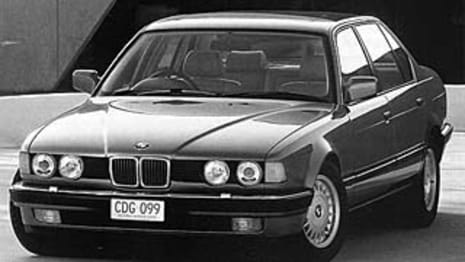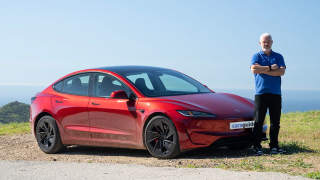
Used Lexus LS400 review: 1990-1994
- Lexus LS 400
- Lexus LS
- Lexus LS 1990
- Lexus LS 1991
- Lexus LS 1992
- Lexus LS 1993
- Lexus LS 1994
- Lexus LS400 1990
- Lexus LS400 1991
- Lexus LS400 1992
- Lexus LS400 1993
- Lexus LS400 1994
- Lexus LS 400 Reviews
- Lexus LS Reviews
- Lexus Reviews
- Lexus Sedan Range
- Sedan
- Lexus
- Used Car Reviews
- Buying tips
When Toyota launched its prestige brand in 1990 it swept through the automotive establishment like a blazing bush fire fanned by a hot midsummer northerly. The luxury LS400 was the first Lexus model to be launched and it so shook up Mercedes-Benz that they haven’t been the same since, and for that we can all be most thankful.
Talking about it recently Cars Guide editor Paul Gover described it as being like the Japanese raid on Pearl Harbour in World War 2. The Japanese bombers arrived unannounced and with devastating effect sent most the American Pacific Fleet to the bottom while they lay at anchor in port. It was a huge setback to the Americans at the time, but it had an even more devastating effect on the Japanese because, as Gover said, it awoke the sleeping giant.
The same can be said for the opening salvo in the Lexus raid on the luxury market segment with the LS400, which caught the established luxury carmakers unaware.
Overnight American buyers switched from the star marque in particular and bought the new Japanese car instead. It was a wake-up call for Mercedes just like the Japanese bombing raid on Hawaii was for the Americans in 1941.
Mercedes-Benz had so dominated the top end of town it was as if they believed they had a God-given right to the luxury market and had become complacent. When the Lexus arrived with an alternative that was just as well equipped, and had all of the technology the Mercedes had, and importantly had much better build quality, many traditional ’Benz buyers jumped ship.
The German company was shaken out of its lethargy and realised that it had to compete for sales if it wanted to keep its pre-eminent position. Before long Mercedes had new, and much improved models on sale, with much higher levels of technology, equipment, and quality. For the first time in years, Mercedes was listening to its customers, and maybe more importantly they listened to those previously loyal customers who’d turned their back on the company.
Mercedes response was, much like the American response in World War 2, devastating for the impertinent aggressor. Toyota was set back on its heels when the Germans counter punched, and the newcomer found itself under the pump.
Proving heritage matters buyers returned to the establishment players and abandoned Lexus once the Germans lifted their game. Lexus, without the heritage to match its European rivals, than had to rely solely on its primary positives of technical sophistication, comfort, and build comfort when they were being matched or bettered by its rivals.
Having given Benz and BMW the wake-up call they badly needed, the Lexus was no longer needed. Selling them became hard work, and the value of used cars dipped.
If you can get past the badge value of the ’Benz there is plenty to recommend the LS400 as a prestige used car buy today.
MODEL WATCH
One look at the LS 400 launched in 1990 is enough to reveal Toyota’s intended target. There are unmistakable cues that recall Mercedes-Benz cars of the time, it’s no wonder Benz buyers were enticed away from Mercedes dealers and into the new Lexus showrooms across town. Replace the Lexus badge with the three-pointed star and you could easily be convinced you were driving a car from Stuttgart.
The LS400 was a conservative shape as demanded by its market segment. Its lines were smooth, but solid and substantial, perfect for executives and others wanting to convey the impression of success.
If the shape was reminiscent of the big German the quality with which it was put together far outstripped anything that was being built in Europe at the time. A tour of the Lexus plant in 1994 just before the LS400 received a major makeover revealed a state-of-the-art factory jam-packed with computer driven robots able to assemble the car to the tightest tolerances. Production engineers were passionate about their ability to consistently turn out high quality, and even a cursory look at the panel fit and body gaps was enough to confirm that they were tight and very consistent. At the time it’s doubtful that there was a car being built with better quality.
What lay below the superbly turned out skin was equally impressive. Suitably it was a 4.0-litre double overhead cam V8 that provided sufficient motivation for the LS400 to race to 100 km/h in a tick over eight seconds with a top speed of 240 km/h. It was fuel-injected, had four valves per cylinder, and pumped out a peak of 190 kW and 360 Nm.
Silkily smooth it was barely evident at normal round town speeds, even at high speed it was totally unfussed with never a murmur to disturb the interior ambience.
The transmission was a four-speed auto, again superbly matched to the engine. Shifts were imperceptible, gearing perfect so progress was always smooth.
Suspension was independent all round, steering was power assisted, and ABS kept a watch on the disc brakes fitted at each corner.
Inside, the LS400 was appropriately equipped with leather trim, power front seats, power mirrors and windows, seven-speaker radio/cassette sound with a six-stacker CD player, cruise control, and a driver’s airbag. Remote central locking along with an alarm and immobiliser kept thieves at bay.
A passenger’s airbag was added in 1992, at the same time 16-inch alloy wheels replaced the 15-inch alloys fitted that were standard from 1990.
IN THE SHOP
Impeccable build quality and renowned Toyota reliability mean there is little that goes wrong with the LS400. Add to that owners who have the wherewithal to look after them, keep them clean and have them properly serviced and they can be bought with confidence.
Even so look carefully for proof of service, particularly a service book with verifiable entries confirming service by a credible service agent. Check engine and transmission vitals and look for fluids that are old and in need of replacement, a sure sign that servicing has been neglected.
Check body carefully for colour mismatches, crook panel fit, variable gaps between panels, which are a sure sign of repairs. Check alloy wheels for damaged caused by being driven into kerbs, and look further for suspension damage if wheels are heavily scarred.
OWNER’S VIEW
Chris Smith bought a 1993 LS400 and loved it for its quality, engine, quietness, comfort and appointments, ride and exterior design, and has no problem with its perceived lack of prestige. His only problem (odo now says 190,000 km) was the replacement of the power steering oil reservoir at 100,000 km for around $1400. He says they are tremendous second hand value.
LOOK FOR
• great build quality with perfect panel gaps and fit.
• silky smooth engine and drive line for fuss free motoring.
• every conceivable comfort and convenience fitment.
• good performance despite weighty body.
• renowned Toyota reliability on a grand scale.
• premium newcomer that lacks prestige of the traditional makes.
Pricing
| Year | Price From | Price To |
|---|---|---|
| 1994 | $5,830 | $10,230 |
| 1993 | $5,830 | $8,250 |
| 1992 | $5,830 | $8,250 |
| 1991 | $4,510 | $6,600 |
| 1990 | $4,510 | $6,600 |
Pricing guides
Range and Specs
| Vehicle | Specs | Price* | |
|---|---|---|---|
| LS400 | 4.0L, PULP, 4 SP AUTO | $4,510 – 6,600 | 1990 Lexus LS 1990 LS400 Pricing and Specs |
$4,510
Lowest price, based on third party pricing data













